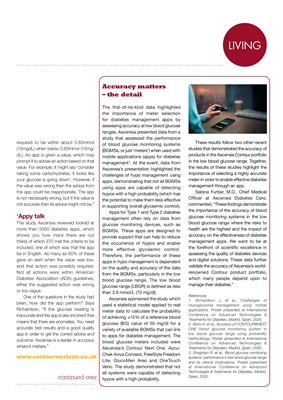
KITLIVING
continued over
required to be within about 0.83mmol
(15mgdL) when below 0.83mmol (15mg/
dL). An app is given a value, which may
prompt it to advise an action based on that
value. For example, it might say 'consider
taking some carbohydrates, it looks like
your glucose is going down'. However, if
the value was wrong then the advice from
the app could be inappropriate. The app
is not necessarily wrong, but if the value is
not accurate then its advice might not be.
'Appy talk
The study Ascensia reviewed looked at
more than 5000 diabetes apps, which
shows you how many there are out
there) of which 370 met the criteria to be
included, one of which was that the app
be in English. As many as 60% of these
gave an alert when the value was low,
and that action was possibly required.
Not all actions were within American
Diabetes Association (ADA) guidelines,
either the suggested action was wrong
or too vague.
One of the questions in the study had
been, how did the app perform? Says
Richardson, "If the glucose reading is
inaccurate and the app is also incorrect that
means that there are anomalies. You need
accurate test results and a good quality
app in order to get the correct advice and
outcome. Ascensia is a leader in accuracy
where it matters."
Accuracy matters
- the detail
The first-of-its-kind data highlighted
the importance of meter selection
for diabetes management apps by
assessing accuracy at low blood glucose
ranges. Ascensia presented data from a
study that assessed the performance
of blood glucose monitoring systems
(BGMSs, or just 'meters') when used with
mobile applications (apps) for diabetes
management1. At the event, data from
Ascensia's presentation highlighted the
challenges of hypo management using
apps, demonstrating that not all BGMSs
using apps are capable of detecting
hypos with a high probability (which has
the potential to make them less effective
in supporting overall glycaemic control).
Apps for Type 1 and Type 2 diabetes
management often rely on data from
glucose monitoring devices, such as
BGMSs. These apps are designed to
provide support that can help to reduce
the occurrence of hypos and enable
more effective glycaemic control.
Therefore, the performance of these
apps in hypo management is dependent
on the quality and accuracy of the data
from the BGMSs, particularly in the low
blood glucose range. The low blood
glucose range (LBGR) is defined as less
than 3.9 mmol/L (70 mg/dl).
Ascensia sponsored the study
used a statistical model applied to real
meter data to calculate the probability
of achieving ±15% of a reference blood
glucose (BG) value of 50 mg/dl for a
variety of available BGMSs that can link
to apps for diabetes management1. The
blood glucose meters included were
Ascensia's Contour Next One, AccuChek Aviva
Connect, FreeStyle Freedom
Lite, GlucoMen Areo and OneTouch
Verio. The study demonstrated that not
all systems were capable of detecting
hypos with a high probability.
These results follow two other recent
studies that demonstrated the accuracy of
products in the Ascensia Contour portfolio
in the low blood glucose range. Together,
the results of these studies highlight the
importance of selecting a highly accurate
meter in order to enable effective diabetes
management through an app.
Sabina Furber, M.D., Chief Medical
Officer at Ascensia Diabetes Care,
commented, "These findings demonstrate
the importance of the accuracy of blood
glucose monitoring systems in the low
blood glucose range where the risks to
health are the highest and the impact of
accuracy on the effectiveness of diabetes
management apps. We want to be at
the forefront of scientific excellence in
assessing the quality of diabetes devices
and digital solutions. These data further
validate the accuracy of Ascensia's worldrenowned
Contour product portfolio,
which many people depend upon to
manage their diabetes."
References
1. Richardson J. et al., Challenges of
Hypoglycemia management using mobile
applications. Poster presented at International
Conference on Advanced Technologies &
Treatments for Diabetes, Madrid, Spain, 2020.
2. Stuhr A. et al., Accuracy of CONTOUR®NEXT
ONE blood glucose monitoring system in
low blood glucose range using probability
methodology. Poster presented at International
Conference on Advanced Technologies &
Treatments for Diabetes, Madrid, Spain, 2020.
3. Shaginian R. et al., Blood glucose monitoring
systems' performance in low blood glucose range
and its clinical implications. Poster presented
at International Conference on Advanced
Technologies & Treatments for Diabetes, Madrid,
Spain, 2020.
www.contournextone.co.uk